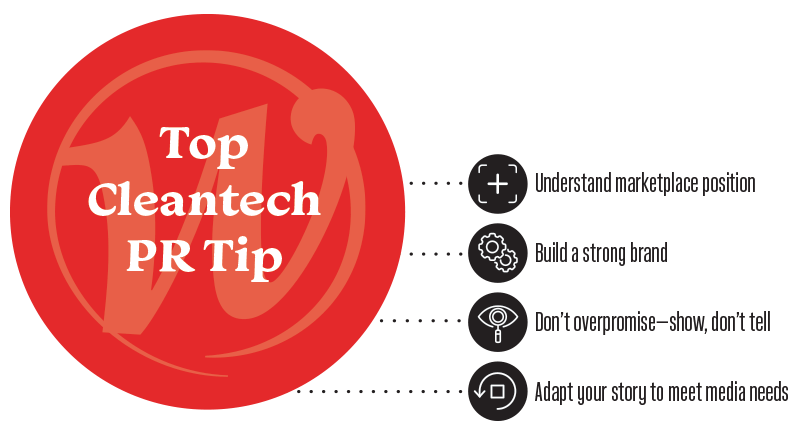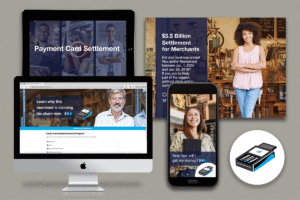
We count ourselves lucky to support climate and energy innovators with cleantech public relations.
But, no matter how ground-breaking an innovator’s solution is, it doesn’t mean anything if their target customer doesn’t know about them or how they can benefit from their tech.
Here are some tips to ensure a successful cleantech public relations program:
Top Cleantech Public Relations Tips for Success

1. Understand how you fit in the marketplace.
Sustainability solutions are coming to market, and they’re coming fast – thankfully.
But this means that at the top of your cleantech company’s to-do-list is being perfectly clear about your position in the broader marketplace.
Just take a look at the number of electric fleet innovations, battery storage companies, solar and wind power producers and the multiple software solutions coming to market to optimize them all.
In a growing sea of competitors, it’s crucial to differentiate yourself and communicate your unique value proposition right out of the gate.
Where to start:
Cleantech companies must think broadly about who their real competitors are. You may be competing against more alternatives than you realize.
Take Uber, for example. It’s easy to think of Uber’s competitors as just Lyft and taxi services. But even as Uber was spearheading the ride-sharing wave, it had to compete against taxis, walking, biking, or just driving yourself. Then came other last-mile solutions like electric scooters, Car2Go and more. Uber and Lyft both jumped into the electric scooter space quickly.
Whether you’re a new cleantech solution, a long-established company branching into more sustainable solutions or a global business entering a new geographic market, start by zooming out to see the big picture and determine where and how you can stand out.
With the growth in cleantech innovation, your competition may not be fossil fuels, internal combustion engines or traditional power sources. You may need to position yourself against other new or emerging climate technologies.
So, start at the 50,000-foot view first, decide where you should fit before you focus your brand messaging and its specific value and contributions.
Good cleantech public relations will start with a true understanding of your business stands in the existing cleantech landscape.
RELATED: Cleantech Public Relations Example
The video below is a news story we helped our client partner, a battery storage company, secure. It’s a great example of a brand that understands its local marketplace, brand position and story:
2. Build a strong platform before you launch.
A strong brand is the platform you need to support your clean tech public relations.
Are you a game-changer or shape-shifter? Having strong, purpose-driven convictions at the heart of your story is really important. You want to avoid coming to market with a brand story that continually pivots as you chase customers or investors. That just creates confusion and never gives your brand a chance to stick.
Where to start:
Assess your strengths so your messaging can amplify them and address your weaknesses to mitigate them before turning your attention outward and inviting the world’s attention.
Questions cleantech brands should ask themselves:
- Is your core technology unique? If not, is it vastly better than the current state of the art?
- What are the pain points that your technology solves for your intended customers?
- What are the barriers to adoption and how does your business model lower them?
- Do you have partners lined up who send clear credibility signals?
- Is there a beta customer, early adopter or willing reference site for your technology to point to?
- Is there white paper content or published research that validates what you’re proposing to demonstrate that it’s more than just greenwashing?
- What are the major trends or market datapoints that support the runway for your growth?
Once your brand messaging is developed, is a content strategy in place so that you have a clear search engine position for the solution you want to be known for? Is your social media engagement building some momentum and community around your ideas and your technology to demonstrate that people care?
Before you go out to media and customers, you must make sure you and your team have that brand platform in place including core messaging that aligns with and promotes your world view matched with discoverable digital content and amplified by active social channels.
RELATED: Learn about our cleantech public relation services HERE.
3. Don’t overpromise—show, don’t tell.
Climate technologies, by their very nature, are expected to change the world and do need to be disruptive to old practices or technologies. But rather than making grandiose claims of revolutionizing the world, it’s wiser to let your portfolio or outcomes speak for itself.
The main goal:
Under-promise and over-deliver. This is an industry with a lot of noise and skepticism is rife.
For instance, say you’re introducing a new home-heating system that uses renewable energy and decreases heating costs by 5%. Will you market on the fact that your tech will change how homes are heated forever, that it’s 5% cheaper or some combination of both?
When your cleantech public relations strategy leads with the cost-savings message and provides your green cred for context, your brand will more likely stay afloat, sell product and avoid drowning in the sea of hyperbole in this industry.
In other words, your sustainable business model is as essential to your cleantech public relations program as your environmental impact.
4. Adapt your story to meet media needs.
Be prepared for your media interviews. At some point in your company’s evolution, and if you’re fortunate enough, you’ll be sitting down with many different journalists.
How to prepare:
Be aware of who you’re speaking with and the audience they represent so that you can adapt your responses.
Some trade media are very knowledgeable about clean technologies, but daily news reporters may not be. So, don’t just start talking.
Read our best media training tips. A good understanding of your interviewer’s credentials and a well-developed plan of action for your interview will help you effectively communicate no matter who sits in the other seat.
What to do if your solution is too complex:
Start all of your interviews by asking the reporter what they already know about your subject. Ideally, your cleantech public relations team will have fully briefed you or your spokesperson on the reporter’s area of interest and knowledge level. But you would be amazed at how many technology executives jump directly into the weeds and speak a mile a minute about their solutions. Best rule? Just ask.
That way, you can provide the right amount of context or background to ensure the reporter grasps the problem your solution addresses and how it does it so brilliantly.
You’d be surprised sometimes how little a reporter might know about cleantech, and if you’re not careful, you’ll be talking over their head and then be unhappy with the published result.
Why it’s important to ask questions first:
You might be tired of repeating the same datapoints or explanations in media interviews and feel like it’s old news and that everybody’s on the same page as you. They’re not!
You’ve got to assess your audience’s knowledge and interest and then meet them where they are.
Asking those probing questions first – or having your cleantech public relations agency do it for you as part of your pre-interview briefing – is always a sound practice!
ABOUT THE AUTHOR: Julie Wright is President of (W)right On Communications, Inc. She has worked with leading investor-owned utilities, community choice aggregators, cleantech startups and billion-dollar clean energy powerhouses.












 Grant Wright
Grant Wright


 Corie Fiebiger
Corie Fiebiger
 Shae Geary
Shae Geary Roman Lukjanenko
Roman Lukjanenko Phelan Riessen
Phelan Riessen Katrina Early
Katrina Early Hamish Marshall
Hamish Marshall
No comment yet, add your voice below!